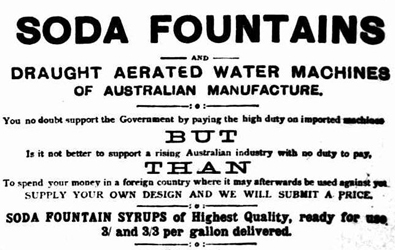BACKGROUND:
Another interesting item from another box of my "Oh my, that's interesting" things ... a very old marble bottle.
I hear you ... what on earth is a marble bottle?
An engineering "wonder" back in the late 1890's, the inventor of the "marble bottle or Codd bottle" was an engineer, Harim Codd, from England. Inside the neck of the bottle is a marble (remember them?) which could move within the neck but not escape from the bottle. The bottles contained carbonated drinks (think of things like Coca Cola) and as the drink releases Carbon Dioxide, this pushed the marble inside the neck up against a rubber seal, preventing the drink from going "flat" - pretty clever huh?
The only question I have always asked myself "how on earth did they get the marble inside the neck?" I couldn't find any sensible clues online but there is no way the mouth of the bottle was "force fed" the marble, the neck is too narrow - somehow the bottle was pressed together with the marble having the neck formed around it - fascinating (to me at least)
This type of "soft drink" bottle was produced and used by many bottle manufacturers in England and Australia for around 40 years, eventually being superseded by other bottle sealing systems in the 1930's.
This bottle is "at least' from the 1920's but could very well be older, I have no way of telling. The bottles are becoming more and more difficult to find, particularly the Australian stamped "variety" and the collectors value tends to be in the company name stamped onto the bottle, not the bottle itself although just finding a Codd bottle, ANY Codd bottle, is not an easy task either!
I bet you are curious what those delicious fizzy drink flavours may have been inside this bottle! Some of the flavours produced by this company were Lemon Twist, Fruita, Lemonade, and Stonie Ginger Beer. Mmmmm...I wonder what they tasted like?
So let's get down to the description of this curious item from yester-year
CARBONATED DRINK BOTTLE
Made in South Australia (we are not sure about this!) because many of the bottles used by all the South Australian soft drink manufacturers (up until the early 20th Century) were made in England, sent over to Australia (usually with beer in them), washed, cleaned and refilled with "fizzy drink"
Circa 1920's but possibly earlier than this.
Adelaide Water Company Limited would appear in fact to be Aerated Waters Co, they were located in Port Adelaide and only operated for a short time, 1913~1922. This company was also associated with Draught Aerated Waters, manufacturers of Soda and aerated water machines. I did also find this interesting advertisement for Draught Aerated Waters, what they are talking about there is the big topic of the present day - tariffs! Encouraging Australians to buy local products and not send money overseas where your money "may afterwards be used against you" - interesting to have a look back in the past (for me anyway!)

There was another soft drink maker called Adelaide Waters And Brewing Company but we don't feel this bottle was one of theirs, they went into receivership in 1898 - this bottle just doesn't look THAT old.
Pressed glass (two seams are visible)
Thick frosted looking glass with the distinctive "pinched neck", the marble inside is clear.
Glass colour is a Lime Green
Holds 8oz of fluid (I checked!)
DIMENSIONS: 8" tall (202mm) x 2.5" diameter (63mm) around the central area, becoming narrower at the top (1.1" or 29mm diameter)
Very thick glass, 8mm estimated (this bottle is a little difficult to get a micrometer into!)
WEIGHT (empty): 438g (imagine a pack of these, that would be a heavy lift!)
IDENTIFICATION MARKINGS:
On one side only is stamped into the glass
PORT ADELAIDE
&
ADELAIDE WATERS Coy LTd
The underside of the bottle is stamped with a large
A
COSMETIC CONDITION:
USED
Clean
Our general thoughts about the bottle condition is "amazement", after so long and there is no physical damage visible.
Obviously, after 95+ years, the original rubber neck seal has long since left this earth!
NO cracks
NO chips (even at the top lip)
NO chips or damage to the marble inside
Yes, pretty obviously visually there is some sort of discoloured material which has left a Whitish coloured powder/residue behind. Washing by hand (soap & water) reduced this residue but did not banish it from the earth! I have heard folks get their bottles steam cleaned, I don't have the equipment to do that and quite frankly, we like the "olde world" look in any case!
This bottle is now within a sealed clear plastic packet, to maintain the current condition (airborne dirt & dust protection) and when it "leaves home" and sets off for new horizons (i.e when it is shipped), it will be well protected in a bed of bubblewrap inside a strong custom made cardboard box to suit.















